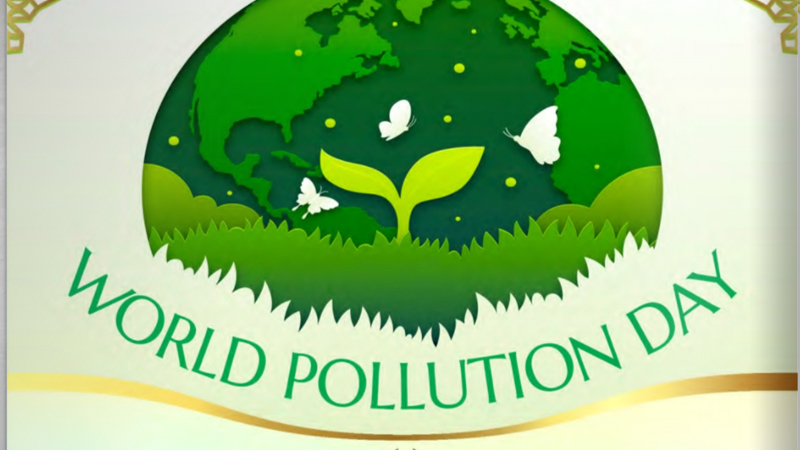World Pollution Day, observed on 2 nd december every year, is a poignant reminder of the growing global concern surrounding environmental pollution. As our world faces an escalating crisis of pollution in its various forms, this article delves into the significance of World Pollution Day, the diverse types of pollution, their far-reaching impacts, and the measures necessary for a cleaner, sustainable future.
Understanding Pollution: The Global Challenge
1. Air Pollution: The Silent Killer
• Air pollution, primarily driven by industrial emissions and vehicle exhaust, has become a pervasive threat to human health and the environment.
• It contributes to respiratory diseases, cardiovascular problems, and climate change.
2. Water Pollution: A Grave Menace to Ecosystems
• Contaminants entering rivers, lakes, and oceans jeopardize aquatic life and human health.
• Inadequate waste management, industrial effluents, and agricultural runoff are key culprits.
3. Plastic Pollution: Suffocating Our Oceans
• The pervasive presence of plastic waste, especially single-use items, has inundated our environment, leading to littered streets, clogged drains, and polluted water bodies.
• Microplastics threaten aquatic ecosystems and can enter the food chain.
4. Noise Pollution: The Modern Disquiet
• Rapid urbanization and industrialization have escalated noise pollution, causing stress, sleep disturbances, and even hearing impairments.
• Chronic noise pollution impacts both mental and physical well-being.
5. Soil Pollution: Imperiling Agriculture
• The use of pesticides and chemical fertilizers in agriculture can lead to soil pollution, which harms crop yields and compromises the environment's integrity.
• Soil contamination affects food safety and reduces agricultural productivity.
Global Initiatives to Combat Pollution
1. Regulatory Reforms: Enforcing Stringent Laws
• Governments worldwide must enact and strictly enforce regulations to control emissions, waste disposal, and industrial practices.
• Regular monitoring and penalties for non-compliance are essential for effective enforcement.
2. Transition to Renewable Energy: Reducing Fossil Fuel Dependence
• Transitioning to renewable energy sources, such as solar and wind power, is crucial to reduce emissions and air pollution.
• Investment in clean energy infrastructure is a global imperative.
3. Waste Management Overhaul: Reducing Plastic and General Waste
• Developing efficient waste management systems, including recycling and proper disposal of hazardous waste, is vital to mitigate pollution.
• Education campaigns should promote responsible waste disposal practices.
4. Public Transportation Investment: Reducing Vehicular Emissions
• Investment in public transportation infrastructure can significantly reduce the number of individual vehicles on the road, which helps decrease air pollution.
• Effective public transportation systems encourage the use of cleaner modes of commuting.
5. Promoting Sustainable Agriculture: Minimizing Chemical Usage
• Governments and agricultural sectors should encourage and adopt sustainable farming practices that reduce chemical usage, promoting organic and regenerative agriculture.
• Sustainable practices can help address soil and water pollution concerns.
6. Educational Campaigns: Raising Public Awareness
• Public awareness campaigns should educate people about the impact of pollution on their health and the environment, encouraging individuals to adopt cleaner and more sustainable habits.
7. International Cooperation: Addressing Cross-Border Pollution
• Pollution knows no borders; cross-border collaboration is critical to address transboundary pollution issues.
• Neighboring nations should work together to reduce environmental contamination.
8. Research and Innovation: Developing Cleaner Technologies
Rank City 2022 average PM2.5 concentration (μg/m³)
- Lahore, Pakistan 97.4
- Hotan, China 94.3
- Bhiwadi, India 92.7
- Delhi, India 92.6
- Peshawar, Pakistan 91.8
- Darbhanga, India 90.3
- Asopur, India 90.2
- N'Djamena, Chad 89.7
- New Delhi, India 89.1
- Patna, India 88.9
• Investment in research and innovation can lead to the development and implementation of cleaner technologies and solutions for pollution reduction.
9. Monitoring and Reporting: Tracking Progress and Accountability
• The establishment of a robust monitoring and reporting system is essential to track
Current situation of air pollution in Pakistan
According to recent reports, Lahore, Pakistan's second-largest city, is frequently ranked among the most polluted cities in the world. High levels of particulate matter (PM2.5 and PM10) and nitrogen dioxide (NO2) have been recorded, significantly impacting air quality and public health.
Air quality index (AQI) readings often exceed recommended levels, leading to health problems, especially for vulnerable populations such as children and the elderly. The government has
taken steps to combat air pollution, including promoting the use of cleaner fuels, improving public transportation, and implementing measures to reduce industrial emissions.
How does this air pollution is causing hazardous affects on health?
1. Particulate Matter (PM2.5 and PM10): PM2.5 and PM10 are tiny particles in the air that can be inhaled, leading to respiratory problems. In Lahore, PM2.5 levels have frequently exceeded the WHO-recommended limit of 10 µg/m³, often reaching levels well above 100 µg/m³ during smog episodes.
2. Nitrogen Dioxide (NO2): NO2, primarily emitted from vehicles and industrial processes, contributes to respiratory diseases. In Lahore, NO2 levels have often exceeded the WHO-recommended limit of 40 µg/m³.
3. Health Impacts: Air pollution in Pakistan is responsible for a significant burden of disease. Respiratory illnesses, cardiovascular problems, and premature deaths are linked to poor air quality. It is estimated that air pollution contributes to thousands of premature deaths annually.
Strategies to Combat Air Pollution in Pakistan
Addressing air pollution in Pakistan requires a multifaceted approach that involves government policies, technological advancements, and community participation.
1. Promotion of Cleaner Fuels: Encouraging the use of cleaner fuels, such as compressed natural gas (CNG) and low-sulfur diesel, in vehicles can significantly reduce emissions of harmful pollutants. Government incentives and regulations play a crucial role in promoting this transition.
2. Improved Public Transportation: Investing in efficient and eco-friendly public transportation systems can reduce the number of vehicles on the road, thereby decreasing emissions. Initiatives like bus rapid transit (BRT) systems and metro projects are steps in the right direction.
3. Industrial Emission Controls: Enforcing stricter regulations on industrial emissions, including the installation of pollution control equipment, can help reduce the contribution of factories and industrial processes to air pollution.
4. Raising Public Awareness: Educating the public about the health risks associated with air pollution is essential. Awareness campaigns can encourage people to adopt cleaner practices, reduce personal emissions, and support policies for cleaner air.
5. Monitoring and Reporting: Implementing effective air quality monitoring systems and providing real-time data to the public can help people make informed decisions about outdoor activities during periods of poor air quality.
6. Green Initiatives: Promoting green spaces and urban forestry can help absorb pollutants and improve air quality in urban areas. The "Clean and Green Pakistan" campaign is one such initiative aimed at enhancing greenery.
Conclusion
Air pollution in Pakistan is a significant environmental and health challenge that demands immediate attention. The current situation, characterized by high levels of particulate matter and nitrogen dioxide, poses serious risks to public health. It is crucial for the government, industry, and the public to work together to combat this issue. By implementing policies that promote cleaner fuels, improving public transportation, controlling industrial emissions, and raising public awareness, Pakistan can make significant strides in reducing air pollution and protecting the health and well-being of its citizens. World Pollution Prevention Day serves as a reminder of our collective responsibility to take action and ensure a cleaner, healthier future.


